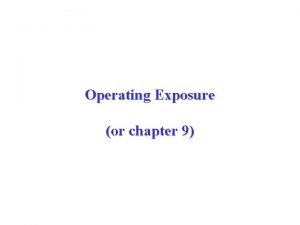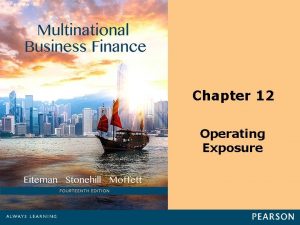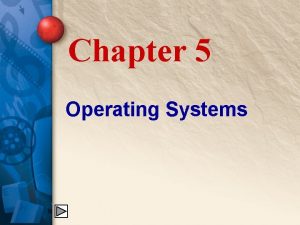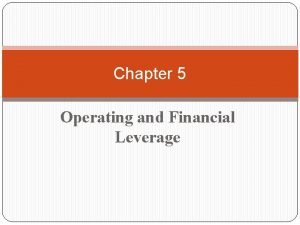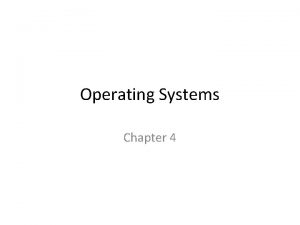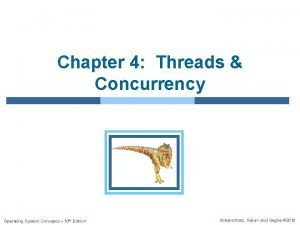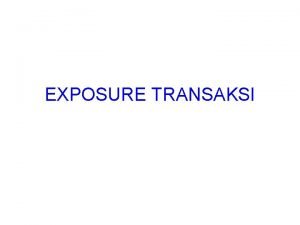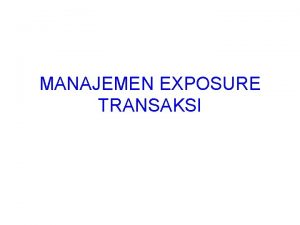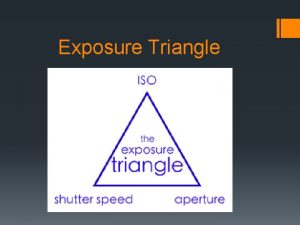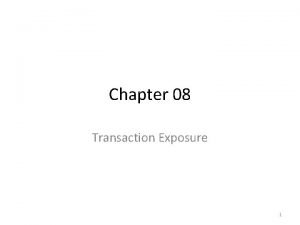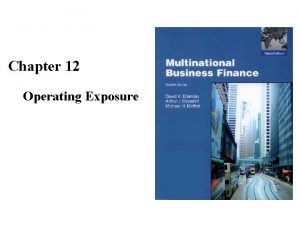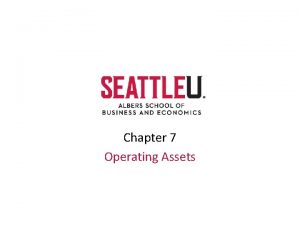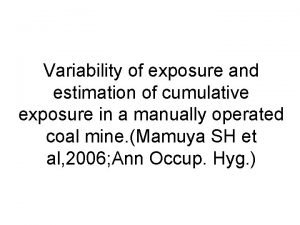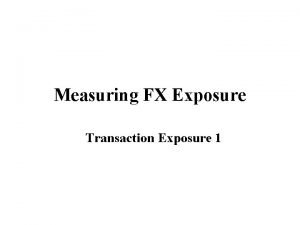Operating Exposure or chapter 9 Agenda Operating exposure



















- Slides: 19

Operating Exposure (or chapter 9)

Agenda § Operating exposure? § How does operating exposure arise? § Forex change: Impact on sales volume, price, & cost variable changes? § Managing operating exposure • Matching cash flows. • Currency clauses. • Back-to-back loans. • Cross-currency swaps. § Contractual Hedges.

Operating Exposure § Analyze change in PV of firm resulting from changes in future operating cash flows & competitive position caused by any unexpected change in exchange rates. • Operating cash flows arise from inter-company and intra • company receivables & payables, rent & lease payments, royalty & licensing fees. Financing cash flows are payments for use of inter- and intra- company loans & stockholder equity.

Operating & Financing Cash Flows Financial Cash Flows Dividend paid to parent Parent invested equity capital Interest on intrafirm lending Intrafirm principal payments Parent Subsidiary Payment for goods & services Rent and lease payments Royalties and license fees Management fees & distributed overhead Operational Cash Flows

Operating Exposure US$ Reporting Lucent US Will altered profits of German subsidiary, in euro, translate into more/ less US $? US$/€ Euro Lucent Suppliers Will costs change w/ $/EUR? Lucent Europe How sales, costs, & profits of German subsidiary change w/ $/EUR? Lucent. Customers Will prices & sales volume change w/ $/EUR?

Lucent’s Operating Exposure § § § § Manufactures w/ European material & labor. Half production sold w/in Europe. All sales invoiced EUR & average collection period 90 days. Inventory 25% of annual direct costs. Depreciation € 600, 000 per annum. Corporate tax 34% in Germany. Assume on Jan. 2003 euro unexpectedly drops 17% from $1. 20/€ to $1. 00/€ – Case 1: Devaluation, no change in costs, prices, sales volume. – Case 2: Devaluation, increase in sales volume only. – Case 3: Devaluation, increase in sales price only.

LUCENT’S OPERATING EXPOSURE

Managing Operating Exposure § Can diversify firm’s operating & financing base. § Diversifying operations: • • diversifying firm sales. diversifying location production facilities. diversifying raw material sources. If firm diversified, management can profit from change in worldwide competitive conditions. § Diversifying financing: raising funds in more capital markets & currencies. • If financially diversified, management can take advantage of deviations from Fisher open.

How to manage operation exposure? § Can partially manage exposure by operating/ § financing policies offsetting anticipated currency exposures. Common policies: • • Matching currency cash flows. Risk-sharing agreements. Back-to-back (parallel) loans. Currency swaps.

Matching Cash Flows § Offset anticipated exposure by same currency § § § denominated debt. Results in continuous same currency receipt of payment & outflow. Preferred for relatively stable & predictable cash flow. Can occur through regular operations (natural hedge) • Combine A/R & A/P in the same currency. • Currency switching.

Matching Currency Cash Flows Canadian Bank Canadian Corporation (buyer of goods) Payment for goods in Canadian $ Exports goods to Canada (loans funds) US Corp borrows Canadian $ debt from Canadian Bank U. S. Corporation Principal & interest payments on debt in Canadian $ Exposure: Inflow of Canadian $ Hedge: Canadian $ debt payments act as financial hedge - an outflow of Canadian $

Risk-sharing Currency Clauses § Contractual arrangement: buyer & seller agree to “share” (split) currency movement impacts on payments • E. g. : Ford has to pay Mazda ¥ 25, 000. • Ford purchases from Mazda in Yen @ current spot if • • spot $ is b/n ¥ 115 & ¥ 125. If spot rate falls outside range, Ford & Mazda share difference. So, if spot ¥ 110/$, Mazda gets payment of

Currency Clauses: Risk-sharing § If spot ¥ 110/$, risk-sharing favors Ford § If spot ¥ 130/$, risk-sharing favors Mazda § Risk-sharing rare during Bretton Woods years.

Back-to-Back (Parallel) Loans § Two firms in different countries arrange to borrow each other’s currency for a specific period of time (credit swap). • • • Two loans for equal values @ current spot. At maturity return borrowed currency. Maintenance-of-principal clause. Conducted outside forex markets, but use spot quotes as reference. Creates covered hedge – Each company borrows same currency as it repays. – No need for collateral. Why? • Difficult to find counterparty. • Counterparty risk.

Back-to-Back Loans 1. British firm wishes to invest funds in its Dutch subsidiary British Petroleum 2. British firm identifies a Dutch firm wishing to invest funds in its British subsidiary Indirect Financing Royal Dutch Shell Direct loan in pounds Shell UK subsidiary 3. British firm loans British pounds directly to the Dutch firm’s British subsidiary Direct loan in euros BP Holland subsidiary 4. British firm’s Dutch subsidiary loans euros to the Dutch parent Provides method for parent-subsidiary cross border financing w/out incurring direct currency exposure.

Currency Swaps § § Dealer & firm agree to exchange equivalent amount of two different currencies for a specified period of time. • Can negotiate wide range of maturities. • Can have fee to compensate for interest rate differential. Like back-to-back loans, except it does not appear on a firm’s balance sheet (FAS 52 & 133). Typically requires two firms to borrow funds in the markets & currencies which they are best known or get best rates (crosscurrency swap). • Maintenance-of-principal clause. Via swap both translation & operating exposure avoided. • Currency swap is treated as forex transaction. • Reversing the swap is treated as a forward contract.

Cross-Currency Swaps Honda Japan Assets Boeing US Liabilities & Equity Inflow Assets Liabilities & Equity Inflow Sales to US of US$ Debt in yen Sales to Japan of yen Receive yen Pay dollars Swap “pay dollars” & “receive yen” Debt in US$ Pay yen Swap Dealer Receive dollars Swap “pay yen” & “receive dollars”

Contractual Approaches § § Undertake long-term currency option hedges to offset lost earnings from adverse changes in forex. Ability to hedge dependent upon strategic predictability of future cash flow & competitor responses • Merck (US) – Highly predictable sales levels. – Highly centralized R&D, production. – Holder OTC put on forex. • Eastman Kodak (US) – Price driven market for its products necessitate forex hedge. – If US$ appreciates, what happens to market share? – Holder put on forex. § What value to hedge? § Costly & ineffectual. Why? • Loss of net earnings from exchange rate losses. • Gross sales revenues.

Things to remember… § Operating Exposure? § How does operating exposure arise? § Managing operating exposure • • Matching currency of cash flow. Currency risk sharing clauses. Back-to-back loans. Cross currency swaps. § Contractual approach.
 Operating exposure
Operating exposure Managing economic exposure and translation exposure
Managing economic exposure and translation exposure How to manage economic exposure
How to manage economic exposure Managing economic exposure and translation exposure
Managing economic exposure and translation exposure Agenda sistemica y agenda institucional
Agenda sistemica y agenda institucional Managing operating exposure
Managing operating exposure Operating exposure
Operating exposure Measuring and managing economic exposure
Measuring and managing economic exposure Components of economic exposure
Components of economic exposure Chapter 17:6 providing first aid for burns
Chapter 17:6 providing first aid for burns Chapter 17:6 providing first aid for burns
Chapter 17:6 providing first aid for burns Chapter 20:1 operating the microscope
Chapter 20:1 operating the microscope 5 operating system
5 operating system Operating and financial leverage
Operating and financial leverage Understanding operating system
Understanding operating system Chapter 4 operating system
Chapter 4 operating system Operating system concepts chapter 8 solutions
Operating system concepts chapter 8 solutions Operating system concepts chapter 5 solutions
Operating system concepts chapter 5 solutions Operating system concepts chapter 5 solutions
Operating system concepts chapter 5 solutions Concurrency vs parallelism in os
Concurrency vs parallelism in os





